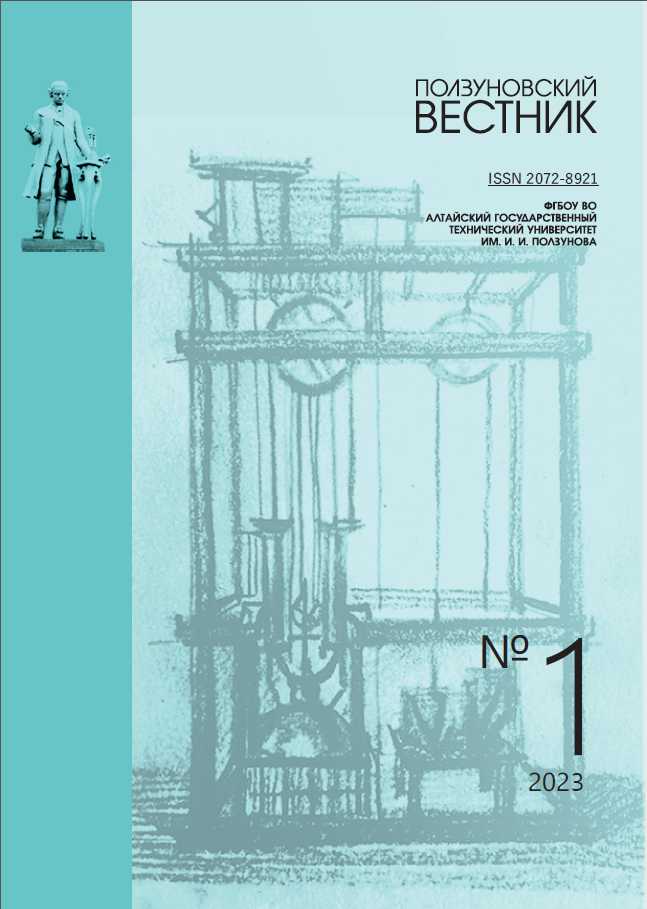EXPERIMENTAL DETERMINATION OF HYDRAULIC RESISTANCE OF A MULTI VORTEX SEPARATOR
GVPTZQ
DOI:
https://doi.org/10.25712/ASTU.2072-8921.2023.01.024Keywords:
hydraulic resistance, multi-vortex separator, vortex structure, separation device, fine particles, separation, pressure loss, vortex device, vortex formation, venturi pipe, filterAbstract
The chemical industry is one of the main sources of fine particle emissions into the environment. They pose a threat to human health, adversely affect the environment and climate change. Particles are difficult to capture with conventional separation technologies. In order to solve the problem, the authors of the work propose the design of a multi-vortex separator. The article presents the principle of its operation. The purpose of this work is to experimentally determine the hydraulic resistance of a multi-vortex separator. The paper considers the influence of two variants of the design of the separator on its hydraulic resistance. In the first version, the purified gas flow exits directly through the separation channels. In the second variant, they installed a cover with round holes for the gas outlet on the back of the separator, which made it possible to form a more stable vortex structure on the separation channels. To determine the hydraulic resistance of a multi-vortex separator, it created an experimental setup, printed element by element on a 3D printer, including a blower, a receiver, a Venturi tube, a multi-vortex separator, and differential pressure gauges. In experimental studies. the dependences of the pressure loss of a multi-vortex separator on the air velocity at the inlet to the device were obtained for both design designs of the device. Based on the studies carried out, the following conclusions were drawn: the hydraulic resistance of a multi-vortex separator with open separation channels Δpop is 14 to 204 Pa at an air velocity at the inlet to the device from 1.4 to 7.7 m/s, the hydraulic resistance of a multi-vortex separator with an installed cover with holes for gas flow outlet Δpcl is from 42 to 1833 Pa at an air velocity at the inlet to the device from 0.8 to 4.9 m/s, the complication of the design leads to an increase in hydraulic resistance and, most likely, an increase in efficiency because of the formation of a more stable vortex structure.
References
Bennett A. Automotive: Innovative filtration ap-plications in the auto industry // Filtr. Sep. 2010. V. 47 N. 1. P. 28-31. DOI 10.1016/S0015-1882(10)70035-5.
Research progress in treatment technology for exhaust gas from spray paint process / N. Sheng [et al.] // Chem. Indust. Eng. Prog. 2017. V. 36. N. 4. P.1434–1447.
Anand S., Howarth J. Automotive finishing: Im-proving filtration in the automotive paint shop // Filtr. Sep. 2013. V. 50. N. 1. P. 22–26. DOI 10.1016/S0015-1882(13)70032-6.
Mohan B.R., Jain R.K., Meikap B.C. Compre-hensive analysis for prediction of dust removal efficien-cy using twin-fluid atomization in a spray scrubber // Sep. Purif. Technol. 2008. V. 63. N. 2. P. 269–277. DOI 10.1016/j.seppur.2008.05.006.
Experimental study on the synergetic removal of fine particles by wet flue gas desulfurization tower with a flow pattern control device / Z. Chen [et al.] // Powder Technol. 2019. V. 343. P. 122–128. DOI 10.1016/j.powtec.2018.11.017.
Effect of particle hydrophilicity on the separa-tion performance of a novel cyclone / Y. Zhang [et al.] // Sep. Purif. Technol. 2020. V. 237. P. 116315. DOI 10.1016/j.seppur.2019.116315
Папко Ю.О. Способы очистки воздуха в окрасочных камерах // Современные технологии в строительстве. Теория и практика. 2017. Т. 2. С. 373–381.
Гавриленков А.М., Бредихин Л.С., Сафара-лиев Р.Р. Совершенствование конструкции узла очистки воздуха, удаляемого из окрасочной камеры // Современные технологии обеспечения граждан-ской обороны и ликвидации последствий чрезвы-чайных ситуаций. 2015. № 1-1 (6). С. 76–78.
Фаскиев Р.С. Мониторинг режимов венти-ляции окрасочно-сушильных камер для ремонтной окраски автомобилей // Вестник Оренбургского государственного университета. 2014. Т. 171. № 10. С. 206–212.
Определение расчетной скорости газового потока в фильтрах грубой и тонкой очистки при различной степени загрязненности в окрасочных камерах / В.Э. Зинуров [и др.] // Известия высших учебных заведений. Проблемы энергетики. 2022. Т. 24. № 5. С. 3–12. DOI 10.30724/1998-9903-2022-24-5-3-12.
Separation of Fine Particles from Gas in Paint-Spraying Booths / R. Y. Bikkulov [et al.] // MATEC Web of Conferences. 2021. V. 346. P. 03070. DOI 10.1051/matecconf/202134603070.
Мультивихревой сепаратор для очистки газов: пат. 208304 Рос. Федерация № 2021120725 / И.Н. Мадышев [и др.]; заявл. 14.07.2021; опубл. 13.12.2021, Бюл. № 35.
ГОСТ 8.586.4-2005. ГСИ. Измерение рас-хода и количества жидкостей и газов с помощью стандартных сужающих устройств. Трубы Вентури. Дата введения 2007-01-01. Москва: Стандартин-форм.
Численное и экспериментальное исследо-вание сужающего устройства на основе трубы Вен-тури / В.Э. Зинуров [и др.] // Вестник технологиче-ского университета. 2022. Т. 25. № 7. С. 106–111. DOI 10.55421/1998-7072_2022_25_7_106.
Экспериментальное определение гидрав-лического сопротивления упрощенной модели мультивихревого классификатора с соосно распо-ложенными трубами / В.Э. Зинуров [и др.] // Ползу-новский вестник. 2022. № 2. С. 108–116. DOI 10.25712/ASTU.2072-8921.2022.02.015.
Downloads
Published
How to Cite
Issue
Section
License
Copyright (c) 2023 Vadim E. Zinurov, Rustem Ya. Bikkulov, Oksana S. Dmitrieva, Ilnur N. Madyshev, Azaliya A. Abdullina

This work is licensed under a Creative Commons Attribution 4.0 International License.
















 .
. This work is licensed under a
This work is licensed under a 
